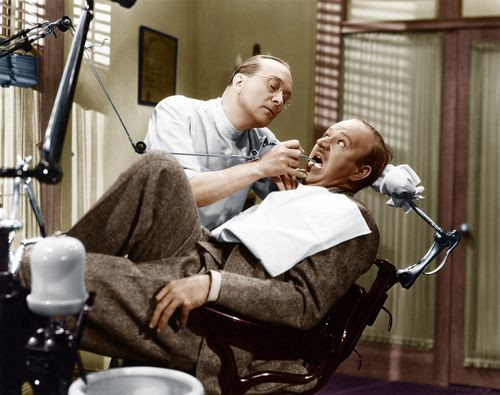Have A Fear Of The Dentist? Brain Scans May Reveal Why Dental Drill Sounds Profoundly Impact The Anxious

Should it come as any surprise that, year after year, dentists rank as some of the most suicidal people in the country? Nobody just drops in to say “Hello.” Nobody leaves feeling better than when they arrived. Even the most gracious “Thank you” is belied by the dread that in six months it’ll all happen again. But for some, going to the dentist is more than just inconvenient. It’s downright terrifying. Fortunately, scientists may now understand what’s going on, neurologically, that causes people to harbor such anxiety, as those who have a fear of the dentist show different neural activity than those who don’t.
Scientists from Japan presented their findings at the annual meeting for The Society for Neuroscience on Sunday. Researcher Hiroyuki Karibe, from Nippon Dental University in Tokyo, said that unraveling the mysteries behind dental anxiety would greatly facilitate therapy programs to treat the constant fears some people hold. Karibe and his colleagues found that people who were severely afraid of the sounds of dental drills and other devices used a different part of their brain to process the sounds than those who merely heard the noises — internalizing the sounds in a part of their brain reserved for learning and memory.
"As a pediatric dentist, I've seen many patients since 1987, and from my clinical experience, I found that the sound of drilling can evoke anxiety in dental patients," Karibe told The Guardian. What remained uncertain, however, was how that anxiety manifested itself neurologically in those patients. So Karibe and his team recruited 21 women and 13 men, between the ages of 14 and 49, to fill out a survey explaining their attitudes toward the dentist.
The survey asked 20 questions in total, such as “Do you get tense during dental treatment?” and “Do you feel anxious when you hear the dental drill?” The team then had each participant strap-in to an fMRI machine so that their brain activity could be monitored in the presence of various dental noises, including the whir of dental drills and the popping of suction instruments. Unfortunately, Karibe said, “we couldn't see if they responded visibly or audibly to the dental sounds,” because the fMRI obstructed their observation. “But we could recognize their responses from their brain activity,” he explained.
What they found in the low-fear group was increased activity in regions of the brain called the left and right superior temporal gyri, which sit just above the outer ear on either side of a person’s head. The superior temporal gyri are responsible, among other things, for auditory processing. Dental drills are more sonically interesting than ambient noise, so the subjects’ brains lit up more when they heard these specific sounds.
By contrast, the high-fear group did not see their superior temporal gyri lighting up when they heard the dental noises. Rather, their left caudate nucleus activated. Nestled deep in the middle of the head, the caudate nucleus is responsible for a number of duties, including learning, sleep, emotion, language comprehension, and, most importantly for Karibe, memory. High-fear patients not only heard the noises, they remembered them. They made associations between the sound of a drill and the anxiety it produced in the past, causing the same emotions to bubble up again.
Approximately 12 percent of the population has high-anxiety when it comes to going to the dentist, according to a U.K. study performed earlier this year. This leads people to skip dental appointments, sometimes avoiding scheduling them altogether, which may lead to greater oral health problems later on. At that point, a vicious cycle emerges. Whereas an appointment may begin as a routine cavity filling, over time the cavity deepens, and treatment becomes more urgent, further dissuading the patient from receiving help.
Karibe argues the proper treatment for dental anxiety is through psychological counseling.
"We believe the findings can be applied to assess the effectiveness of interventions such as cognitive behavior therapy for patients who have a strong fear of dental treatment," he told The Guardian. A separate study conducted in 2012 showed that dental anxiety made a person four times more likely to experience pain during a procedure than non-anxious patients.
In this sense, dental anxiety is reinforced not merely as discomfort, but as physical manifestations of a mental process. It’s not uneasiness, but suffering.
Luckily for dentists, experienced pain is relatively uncommon among patients. Martin Tickle, professor of dental public health at Manchester University and leader of the 2012 survey, argues that brain scans probably won’t make the anxious patients feel less marginalized than researchers may hope. They may simply reinforce the abnormality.
"I don't think the answer for the NHS lies with giving dentally anxious patients brain scans. The first thing we need to do is prevent dental caries in young children to stop them having to have extractions, as the most common reason why children have a general anesthetic is to have decayed teeth extracted," he said. He added, like Karibe, that therapy sessions, where patients can discuss their fears in a safe environment, could be beneficial.
"We also need to improve the amount and quality of research looking at how to effectively manage children and adults who are dentally anxious,” he said, “and provide guidelines for dentists on how to use research-proven interventions.”



























